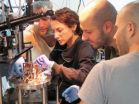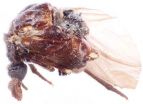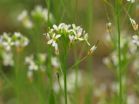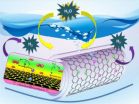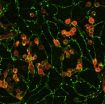(Press-News.org) More than 140 years ago, Charles Darwin noticed something peculiar about domesticated mammals. Compared to their wild ancestors, domestic species are more tame, and they also tend to display a suite of other characteristic features, including floppier ears, patches of white fur, and more juvenile faces with smaller jaws. Since Darwin's observations, the explanation for this pattern has proved elusive, but now, in a Perspectives article published in the journal GENETICS, a new hypothesis has been proposed that could explain why breeding for tameness causes changes in such diverse traits.
The underlying link between these features could be the group of embryonic stem cells called the neural crest, suggest the authors. Although this proposal has not yet been tested, it is the first unified hypothesis that connects several components of the "domestication syndrome." It not only applies to mammals like dogs, foxes, pigs, horses, sheep and rabbits, but it may even explain similar changes in domesticated birds and fish.
"Because Darwin made his observations just as the science of genetics was beginning, the domestication syndrome is one of the oldest problems in the field. So it was tremendously exciting when we realized that the neural crest hypothesis neatly ties together this hodge-podge of traits," says Adam Wilkins, from the Humboldt University of Berlin. Wilkins is an editor at GENETICS and one of the paper's authors.
Neural crest cells are formed near the developing spinal cord of early vertebrate embryos. As the embryo matures, the cells migrate to different parts of the body and give rise to many tissue types. These tissues include pigment cells and parts of the skull, jaws, teeth, and ears—as well as the adrenal glands, which are the center of the "fight-or-flight" response. Neural crest cells also indirectly affect brain development.
In the hypothesis proposed by Wilkins and co-authors Richard Wrangham of Harvard University and Tecumseh Fitch of the University of Vienna, domesticated mammals may show impaired development or migration of neural crest cells compared to their wild ancestors.
"When humans bred these animals for tameness, they may have inadvertently selected those with mild neural crest deficits, resulting in smaller or slow-maturing adrenal glands," Wilkins says. "So, these animals were less fearful."
But the neural crest influences more than adrenal glands. Among other effects, neural crest deficits can cause depigmentation in some areas of skin (e.g. white patches), malformed ear cartilage, tooth anomalies, and jaw development changes, all of which are seen in the domestication syndrome. The authors also suggest that the reduced forebrain size of most domestic mammals could be an indirect effect of neural crest changes, because a chemical signal sent by these cells is critical for proper brain development.
"This interesting idea based in developmental biology brings us closer to solving a riddle that's been with us a long time. It provides a unifying hypothesis to test and brings valuable insight into the biology of domestication," says Mark Johnston, Editor-in-Chief of GENETICS.
Tests of the neural crest hypothesis may not be far off, as other scientists are rapidly mapping the genes that have been altered by domestication in the rat, fox, and dog. The hypothesis predicts that some of these genes will influence neural crest cell biology.
If so, we will have a much deeper understanding of the biology underlying a significant evolutionary event, Wilkins says. "Animal domestication was a crucial step in the development of human civilizations. Without these animals, it's hard to imagine that human societies would have thrived in the way they have."
INFORMATION:
Citation: The "Domestication Syndrome" in Mammals: A Unified Explanation Based on Neural Crest Cell Behavior and Genetics
Adam S. Wilkins, Richard W. Wrangham, and W. Tecumseh Fitch. GENETICS July 2014, 197:795-808, doi: 10.1534/genetics.114.165423
http://www.genetics.org/content/197/3/795.full
Photo credit: Helios, an approximately 3-year-old cattle dog/greyhound mix with Lucky Dog Animal Rescue. Photo courtesy Lucky Dog Animal Rescue http://www.luckydoganimalrescue.org
About GENETICS
Since 1916, GENETICS has published high quality, original research on a range of topics bearing on inheritance, including population and evolutionary genetics, complex traits, developmental and behavioral genetics, cellular genetics, gene expression, genome integrity and transmission, and genome and systems biology. A peer-reviewed and peer-edited publication of the Genetics Society of America, GENETICS is one of the world's most cited journals in genetics and heredity.
About the Genetics Society of America (GSA)
Founded in 1931, the Genetics Society of America (GSA) is the professional scientific society for genetics researchers and educators. The Society’s more than 5,000 members worldwide work to deepen our understanding of the living world by advancing the field of genetics, from the molecular to the population level. GSA promotes research and fosters communication through a number of GSA-sponsored conferences including regular meetings that focus on particular model organisms. GSA publishes two peer-reviewed, peer-edited scholarly journals: GENETICS, which has published high quality original research across the breadth of the field since 1916, and G3: Genes|Genomes|Genetics, an open-access journal launched in 2011 to disseminate high quality foundational research in genetics and genomics. The Society also has a deep commitment to education and fostering the next generation of scholars in the field. For more information about GSA, please visit http://www.genetics-gsa.org.
Domestication syndrome: White patches, baby faces and tameness
Neural crest hypothesis could explain why domestic mammals share characteristic traits
2014-07-14
ELSE PRESS RELEASES FROM THIS DATE:
UEA research reveals how cannabis compound could slow tumour growth
2014-07-14
Scientists at the University of East Anglia have shown how the main psychoactive ingredient in cannabis could reduce tumor growth in cancer patients.
Research published today reveals the existence of previously unknown signaling platforms which are responsible for the drug's success in shrinking tumours.
It is hoped that the findings could help develop a synthetic equivalent with anti-cancer properties.
The research was co-led with the Universidad Complutense de Madridin, Spain. The team used samples of human breast cancer cells to induce tumours in mice. They ...
The world's first photonic router
2014-07-14
Weizmann Institute scientists have demonstrated for the first time a photonic router – a quantum device based on a single atom that enables routing of single photons by single photons. This achievement, as reported in Science magazine, is another step toward overcoming the difficulties in building quantum computers.
At the core of the device is an atom that can switch between two states. The state is set just by sending a single particle of light – or photon – from the right or the left via an optical fiber. The atom, in response, then reflects or transmits the next incoming ...
Serendipity at the Smithsonian: The 107-year journey of the beetle Rhipidocyrtus muiri
2014-07-14
Serendipity leads University of Kansas scientists to the discovery and description of Rhipidocyrtus muiri - a 107 year old, lost in collections specimen, which turned out to represent a new genus and species. The long and tortuous history of the enigmatic ripidiine wedge beetle from Borneo is discussed in a recent paper published in the open access journal ZooKeys.
The holotype male, and only known specimen of Rhipidocyrtus muiri, was collected 107 years ago in Borneo but subsequent to this it was transferred among several researchers in the early 1900s. The specimen ...
Best for bees to be stay-at-homes
2014-07-14
Honey bees with roots in the local environment manage much better in the struggle for survival than imported honey bees from foreign environments.
A world without bees would be a whole lot poorer – literally. In Denmark alone an additional 600 million to 1 billion Danish kroner are earned annually due to the work done by bees making honey and pollinating a wide range of crops from apples to cherries and clover.
Unfortunately, bees all over the world are under pressure from pesticides, mites, viruses, bacteria, fungi and environmental changes, among other things. The ...
Molecular mechanisms underlying the prevention of autoim-munity by Roquin revealed
2014-07-14
The Roquin protein, discovered in 2005, controls T-cell activation and differentiation by regulating the expression of certain mRNAs. In doing so, it helps to guarantee immunological tolerance and prevents immune responses against the body's own structures that can lead to autoimmune disease. Roquin is thus an immune regulator. Autoimmune diseases affect between five and ten per cent of the population. They usually occur as a result of complex environmental influences when a genetic predisposition exists. Only in rare cases the development of the disease is determined by ...
Flower development in 3D: Timing is the key
2014-07-14
In close collaboration with Jürg Schönenberger and Yannick Städler from the Department of Botany and Biodiversity Research of the Faculty of Life Sciences, University of Vienna, 14 developmental stages of the flower of Arabidopsis thaliana from very early meristematic floral initiation to fully developed seeds were monitored with micro-computed tomography in 3D. From the same set of developmental stages a full metabolic profile using mass spectrometry was measured covering hundreds of biochemical pathways.
"Smallest changes in floral organ development were thus correlated ...
A-maize-ing double life of a genome
2014-07-14
Early maize farmers selected for genes that improved the harvesting of sunlight, a new detailed study of how plants use 'doubles' of their genomes reveals. The findings could help current efforts to improve existing crop varieties.
Oxford University researchers captured a 'genetic snapshot' of maize as it existed 10 million years ago when the plant made a double of its genome – a 'whole genome duplication' event. They then traced how maize evolved to use these 'copied' genes to cope with the pressures of domestication, which began around 12,000 years ago. They discovered ...
Rutgers chemists develop technology to produce clean-burning hydrogen fuel
2014-07-14
Rutgers researchers have developed a technology that could overcome a major cost barrier to make clean-burning hydrogen fuel – a fuel that could replace expensive and environmentally harmful fossil fuels.
The new technology is a novel catalyst that performs almost as well as cost-prohibitive platinum for so-called electrolysis reactions, which use electric currents to split water molecules into hydrogen and oxygen. The Rutgers technology is also far more efficient than less-expensive catalysts investigated to-date.
"Hydrogen has long been expected to play a vital role ...
Wisconsin scientists find genetic recipe to turn stem cells to blood
2014-07-14
MADISON, Wis. — The ability to reliably and safely make in the laboratory all of the different types of cells in human blood is one key step closer to reality.
Writing today in the journal Nature Communications, a group led by University of Wisconsin-Madison stem cell researcher Igor Slukvin reports the discovery of two genetic programs responsible for taking blank-slate stem cells and turning them into both red and the array of white cells that make up human blood.
The research is important because it identifies how nature itself makes blood products at the earliest ...
Testicular cancer rates are on the rise in young Hispanic Americans
2014-07-14
A new analysis has found that rates of testicular cancer have been rising dramatically in recent years among young Hispanic American men, but not among their non-Hispanic counterparts. Published early online in Cancer, a peer-reviewed journal of the American Cancer Society, the findings indicate that greater awareness is needed concerning the increasing risk of testicular cancer in Hispanic adolescents and young adults, and that research efforts are needed to determine the cause of this trend.
Testicular cancer is one of the most common types of cancer among adolescent ...
LAST 30 PRESS RELEASES:
Beech trees use seasonal soil moisture to optimize water uptake
How thinning benefits growth for all trees
Researchers upgrades 3-PG forest model for improved accuracy
Achieving anti-thermal-quenching in Tb3+-doped glass scintillators via dual-channel thermally enhanced energy transfer
Liquid metal modified hexagonal boron nitride flakes for efficient electromagnetic wave absorption and thermal management
Failure mechanisms in PEM water electrolyzers
Study captures how cancer cells hide from brain immune cells, shows that removing their “don’t eat me” signals stops their escape
New breakthrough in detecting ‘ghost particles’ from the Sun
Half of people arrested in London may have undiagnosed ADHD, study finds
From dots to lines: new database catalogs human gene types using ’ACTG’ rules
Persistent antibiotic resistance of cholera-causing bacteria in Africa revealed from a multinational workshop for strengthening disease surveillance
SwRI, Trinity University to synthesize novel compound to mitigate effects of stroke, heart attack
Novel endocrine therapy giredestrant improves disease-free survival over standard of care for patients with early-stage breast cancer in phase III lidERA trial
Gen Z views world as "scary place" with growing cynicism about ability to create change
Biosensor performance doubled – New applications possible
Leveraging incomplete remote sensing for forest inventory
Key chemical in dark chocolate may slow down ageing
New 15-minute hepatitis C test paves the way for same-day treatment
Uranus and Neptune might be rock giants
Magnetically actuated soft electrodes for multisite bioelectrical monitoring of ex vivo tissues
FAU engineers decode dementia type using AI and EEG brainwave analysis
Carrier-free peptide–daunorubicin–small interfering RNA nanoassembly for targeted therapy of acute myeloid leukemia
Global Virus Network announces appointment of new board members
Artificial beaver dams show promise in offsetting climate change effects
Could hidden infections be fueling long COVID?
Targeted oxygen for initial resuscitation of preterm infants
Researchers develop models to help diagnose ALS earlier through blood biomarkers
Jeonbuk National University researchers develop novel eco-friendly and photo-switchable smart adhesives
Magnetic ordering induces Jahn–Teller effect in spinel-type compounds
A mitochondrial protein may hold the secret to longevity, new study finds
[Press-News.org] Domestication syndrome: White patches, baby faces and tamenessNeural crest hypothesis could explain why domestic mammals share characteristic traits

